Reaction of Secondary and Tertiary Amines with Nitric Oxide in the ...
Reaction of Secondary and Tertiary Amines with Nitric Oxide in the ...
Reaction of Secondary and Tertiary Amines with Nitric Oxide in the ...
You also want an ePaper? Increase the reach of your titles
YUMPU automatically turns print PDFs into web optimized ePapers that Google loves.
June 1999 Chem. Pharm. Bull. 47(6) 819—823 (1999) 819<br />
<strong>Reaction</strong> <strong>of</strong> <strong>Secondary</strong> <strong>and</strong> <strong>Tertiary</strong> <strong>Am<strong>in</strong>es</strong> <strong>with</strong> <strong>Nitric</strong> <strong>Oxide</strong> <strong>in</strong> <strong>the</strong><br />
Presence <strong>of</strong> Oxygen<br />
Takashi ITOH, Yûji MATSUYA, Hiromi MAETA, Michiko MIYAZAKI, Kazuhiro NAGATA, <strong>and</strong><br />
Akio OHSAWA*<br />
School <strong>of</strong> Pharmaceutical Sciences, Showa University, 1–5–8 Hatanodai, Sh<strong>in</strong>agawa-ku, Tokyo 142–8555, Japan.<br />
Received January 12, 1999; accepted February 24, 1999<br />
In order to clarify <strong>the</strong> role <strong>of</strong> oxygen <strong>in</strong> <strong>the</strong> reaction <strong>of</strong> am<strong>in</strong>es <strong>with</strong> nitric oxide, secondary am<strong>in</strong>es were allowed<br />
to react <strong>with</strong> nitric oxide <strong>in</strong> <strong>the</strong> presence <strong>of</strong> oxygen. Although N-nitrosam<strong>in</strong>es were obta<strong>in</strong>ed as <strong>the</strong> ma<strong>in</strong><br />
products <strong>in</strong> every case, <strong>the</strong> yields depended on <strong>the</strong> substituents <strong>and</strong> reaction solvents. Detailed <strong>in</strong>vestigation revealed<br />
that <strong>the</strong> reaction proceeded by at least two pathways: one <strong>in</strong>volv<strong>in</strong>g oxygen as a catalyst, <strong>and</strong> <strong>the</strong> o<strong>the</strong>r<br />
consum<strong>in</strong>g <strong>the</strong> stoichiometric amount <strong>of</strong> oxygen. Both paths afforded <strong>the</strong> same nitroso adducts. It was suggested<br />
that a third path, a catalytic process via Drago’s salts was also possible. The same reaction was applied to a tertiary<br />
am<strong>in</strong>e, <strong>and</strong> it was found that <strong>the</strong> oxygen was consumed stoichiometrically <strong>in</strong> this case.<br />
Key words nitric oxide; d<strong>in</strong>itrogen trioxide; nitrosation; N-nitrosam<strong>in</strong>e<br />
In spite <strong>of</strong> its simple structure, nitric oxide (NO) has been<br />
found to play a variety <strong>of</strong> roles <strong>in</strong> biological systems, <strong>and</strong> extensive<br />
biological <strong>and</strong> physiological research has been carried<br />
out. 1) From a chemical viewpo<strong>in</strong>t, NO itself has been<br />
found to exhibit low reactivity toward most organic molecules<br />
2) <strong>with</strong> a few exceptions. 3) In <strong>the</strong> presence <strong>of</strong> oxygen,<br />
NO is converted to higher nitrogen oxides which have <strong>the</strong><br />
ability to react <strong>with</strong> organic compounds <strong>in</strong> a variety <strong>of</strong> ways.<br />
Many <strong>of</strong> <strong>the</strong> reactions, however, are unproducible because<br />
<strong>the</strong> reaction <strong>of</strong> NO <strong>with</strong> O 2 gives a variety <strong>of</strong> nitrogen<br />
oxides 4) depend<strong>in</strong>g upon <strong>the</strong> ratio <strong>of</strong> <strong>the</strong> two gases, <strong>and</strong> <strong>the</strong><br />
pressure, solvent, <strong>and</strong> reaction temperature used.<br />
We have been study<strong>in</strong>g <strong>the</strong> reaction <strong>of</strong> NO <strong>with</strong> am<strong>in</strong>es<br />
<strong>and</strong> have been confronted by this difficulty. 5) In order to <strong>in</strong>vestigate<br />
<strong>the</strong> detailed reaction mechanism, <strong>the</strong> amount <strong>of</strong><br />
oxygen <strong>in</strong> <strong>the</strong> reaction system has to be carefully controlled,<br />
<strong>and</strong> <strong>the</strong> effect <strong>of</strong> oxygen on <strong>the</strong> reaction <strong>of</strong> secondary <strong>and</strong> tertiary<br />
am<strong>in</strong>es <strong>with</strong> NO was <strong>in</strong>vestigated. It was found that NO<br />
reacts <strong>with</strong> am<strong>in</strong>es <strong>in</strong> at least two different ways depend<strong>in</strong>g<br />
upon <strong>the</strong> substrates <strong>and</strong> reaction conditions. This paper describes<br />
our results. 6)<br />
<strong>Secondary</strong> am<strong>in</strong>es were selected as substrates because <strong>the</strong>y<br />
give N-nitrosam<strong>in</strong>es as <strong>the</strong> sole products follow<strong>in</strong>g reaction<br />
<strong>with</strong> nitrosat<strong>in</strong>g agents. There have been two studies which<br />
reported <strong>the</strong> reaction <strong>of</strong> NO <strong>with</strong> secondary am<strong>in</strong>es. Drago<br />
showed that secondary am<strong>in</strong>es reacted <strong>with</strong> NO under high<br />
pressure or at low temperature to give a 1 : 2 complex <strong>of</strong><br />
am<strong>in</strong>e <strong>and</strong> NO, <strong>the</strong> so-called Drago’s salts. 7) In addition,<br />
Challis <strong>and</strong> Kyrtopoulos reported that NO did not react <strong>with</strong><br />
secondary am<strong>in</strong>es <strong>in</strong> <strong>the</strong> absence <strong>of</strong> O 2 <strong>in</strong> acetonitrile, <strong>and</strong> a<br />
trace amount <strong>of</strong> O 2 accelerated N-nitrosation, although <strong>the</strong><br />
amount <strong>of</strong> O 2 used was not reported. 8) S<strong>in</strong>ce <strong>the</strong>se two studies<br />
adopted different substrates <strong>and</strong> solvents, it is impossible<br />
to draw firm conclusions. For <strong>the</strong> <strong>in</strong>vestigation <strong>of</strong> <strong>the</strong> detailed<br />
reaction mechanism <strong>of</strong> N-nitrosation <strong>with</strong> NO <strong>and</strong> O 2 , catalytic<br />
amount <strong>of</strong> oxygen (0.1 eq) was used for <strong>the</strong> reaction <strong>of</strong><br />
NO (5 eq) <strong>with</strong> N-methylanil<strong>in</strong>e (1a) because, <strong>in</strong> <strong>the</strong> presence<br />
<strong>of</strong> excess NO, <strong>the</strong> small amount <strong>of</strong> O 2 should be converted<br />
to d<strong>in</strong>itrogen trioxide N 2 O 3 accord<strong>in</strong>g to Eqs 1 <strong>and</strong> 2, 9)<br />
<strong>and</strong> <strong>the</strong> reaction atmosphere must consist <strong>of</strong> a small amount<br />
<strong>of</strong> N 2 O 3 <strong>and</strong> excess NO.<br />
2NOO 2 →2NO 2<br />
NO 2 NO→ ←N 2 O 3<br />
(1)<br />
(2) 10)<br />
Under <strong>the</strong>se conditions, <strong>the</strong> reactions <strong>of</strong> N-methylanil<strong>in</strong>e <strong>in</strong><br />
various solvents were <strong>in</strong>vestigated <strong>and</strong> <strong>the</strong> results are shown<br />
<strong>in</strong> Table 1. In <strong>the</strong> case <strong>of</strong> non-polar solvents, <strong>the</strong> reaction was<br />
completed <strong>with</strong><strong>in</strong> 24 h to afford <strong>the</strong> correspond<strong>in</strong>g N-nitrosam<strong>in</strong>e<br />
<strong>in</strong> almost quantitative yield despite <strong>the</strong> absence <strong>of</strong><br />
a sufficient amount <strong>of</strong> O 2 . With an <strong>in</strong>crease <strong>in</strong> <strong>the</strong> polarity <strong>of</strong><br />
<strong>the</strong> solvents, however, <strong>the</strong> yield became lower <strong>and</strong>, <strong>in</strong> acetone<br />
or H 2 O solution, <strong>the</strong> reaction stopped after about 40% <strong>of</strong> <strong>the</strong><br />
start<strong>in</strong>g material had been consumed. This yield was thought<br />
to be obta<strong>in</strong>ed from <strong>the</strong> stoichiometry shown <strong>in</strong> Eq. 3, i.e. 0.1<br />
eq <strong>of</strong> O 2 corresponds to 0.4 eq <strong>of</strong> product.<br />
RRNHNO1/4 O 2 →RRNNO1/2 H 2 O (3)<br />
These results suggest that catalytic behavior <strong>of</strong> O 2 was observed<br />
<strong>in</strong> <strong>the</strong> case <strong>of</strong> non-polar solvents, whereas O 2 was<br />
consumed stoichiometrically <strong>in</strong> polar solvents.<br />
Chart 1<br />
Table 1. <strong>Reaction</strong> <strong>of</strong> N-Methylanil<strong>in</strong>e <strong>with</strong> NO <strong>in</strong> Various Solvents<br />
Entry Solvent 9)<br />
∗ To whom correspondence should be addressed. © 1999 Pharmaceutical Society <strong>of</strong> Japan<br />
Yield <strong>of</strong> 2a (%) a)<br />
3h 24h 72h<br />
1 DCE 44 (55) 100 —<br />
2 Benzene 44 (55) 100 —<br />
3 CHCl 3 38 (62) 100 —<br />
4 THF 42 (54) 66 (33) 65 (33)<br />
5 AcOEt 53 (47) 57 (40) 54 (40)<br />
6 Acetone 33 (67) 41 (56) 41 (57)<br />
7 MeOH 7 (85) 12 (76) —<br />
8 H 2 O 17 (75) 42 (39) 34 (42)<br />
a) Values <strong>in</strong> paren<strong>the</strong>ses correspond to <strong>the</strong> recovery <strong>of</strong> 1a (%).
820 Vol. 47, No. 6<br />
In order to study <strong>the</strong> substituent effects, various secondary<br />
am<strong>in</strong>es were used as substrates <strong>in</strong> 1,2-dichloroethane (DCE)<br />
solution 11) (Chart 2 <strong>and</strong> Table 2). In <strong>the</strong> case <strong>of</strong> aromatic<br />
am<strong>in</strong>es, <strong>the</strong> reaction was completed after 24 h (entries 1—3),<br />
but aliphatic am<strong>in</strong>es afforded <strong>the</strong> correspond<strong>in</strong>g N-nitrosam<strong>in</strong>es<br />
<strong>in</strong> less than 40 % yield (entries 4—6). The results<br />
also suggested that different reaction pathways were <strong>in</strong>volved<br />
<strong>with</strong> <strong>the</strong>se two types <strong>of</strong> am<strong>in</strong>es. Thus, competition experiments<br />
were carried out to clarify <strong>the</strong> detailed substituent effects<br />
us<strong>in</strong>g compound 1a as a reference (Chart 3 <strong>and</strong> Table<br />
3), <strong>and</strong> aromatic am<strong>in</strong>es tended to give more products when<br />
<strong>the</strong> oxidation potential was lower (entries 1, 2), while<br />
aliphatic am<strong>in</strong>es were nitrosated faster than aromatic ones, <strong>in</strong><br />
spite <strong>of</strong> <strong>the</strong>ir higher oxidation potential (entries 3—5). Thus,<br />
aromatic <strong>and</strong> aliphatic am<strong>in</strong>es were found to react <strong>with</strong> NO<br />
(or N 2 O 3 ) through different pathways. In <strong>the</strong> case <strong>of</strong> aliphatic<br />
am<strong>in</strong>es, <strong>the</strong> reaction proceeds by attack <strong>of</strong> NO , which is sto-<br />
Table 2. <strong>Reaction</strong> <strong>of</strong> <strong>Secondary</strong> <strong>Am<strong>in</strong>es</strong> <strong>with</strong> NO <strong>in</strong> <strong>the</strong> Presence <strong>of</strong> O 2<br />
Entry Substrate R 1<br />
Oxidation Yield (%) <strong>of</strong> 2<br />
potential<br />
(vs. SCE) a) 3 h 24 h<br />
1 1a Ph Me 1.10 V 44 100<br />
2 1b p-Cl-C 6 H 4 Me 1.20 V 47 100<br />
3 1c p-NO 2 -C 6 H 4 Me 1.45 V 50 90<br />
4 1d PhCH 2 Me 1.55 V 34 38<br />
5 1e PhCH 2 PhCH 2 1.50 V 32 32<br />
6 1f PhCH 2 CH 2 Me 1.55 V 26 26<br />
a) SCE: saturated calomel electrode.<br />
Chart 2<br />
R 2<br />
Chart 4<br />
ichiometrically formed from N 2 O 3 , on <strong>the</strong> am<strong>in</strong>e lone pair<br />
(Chart 4, pathway A). This pathway affords HNO 2 , which results<br />
<strong>in</strong> N 2 O 3 by dimerization. Thus, pathway A consumes<br />
one equivalent <strong>of</strong> NO to form 2. This ionic process should be<br />
dom<strong>in</strong>ant <strong>in</strong> polar solvents, which is <strong>in</strong> good agreement <strong>with</strong><br />
<strong>the</strong> data shown <strong>in</strong> Table 1. On <strong>the</strong> o<strong>the</strong>r h<strong>and</strong>, aromatic<br />
am<strong>in</strong>es are weaker bases than <strong>the</strong>ir aliphatic counterparts,<br />
thus reaction via pathway A will be slower than <strong>with</strong><br />
aliphatic am<strong>in</strong>es. However, <strong>the</strong>se compounds have lower oxidation<br />
potentials, <strong>and</strong> one-electron oxidation might be advantageous,<br />
switch<strong>in</strong>g <strong>the</strong> reaction process from pathway A to<br />
pathway B. On this occasion, N 2 O 3 acts <strong>in</strong> a catalytic manner,<br />
provided that N 2 O 3 accepts one electron from <strong>the</strong> am<strong>in</strong>e to<br />
form NO <strong>and</strong> NO 2 . 12,13) There is an ano<strong>the</strong>r possible pathway<br />
that must be considered <strong>in</strong> this reaction system, i.e. a<br />
process that <strong>in</strong>volves a Drago’s salt 8 as an <strong>in</strong>termediate<br />
(pathway C). When secondary am<strong>in</strong>es were used as substrates,<br />
<strong>the</strong> total yields <strong>of</strong> <strong>the</strong> recovered start<strong>in</strong>g materials <strong>and</strong><br />
N-nitrosam<strong>in</strong>es were almost quantitative <strong>in</strong> every case. Thus,<br />
Table 3. Competitive <strong>Reaction</strong> <strong>of</strong> <strong>Am<strong>in</strong>es</strong> <strong>with</strong> NO Us<strong>in</strong>g 1a as a Reference<br />
Substrate<br />
Entry Substrate<br />
Chart 3<br />
Yield (%)<br />
2a 2b—f<br />
1 1b 50 23<br />
2 1c 32 4<br />
3 1d 2 24<br />
4 1e 16 27<br />
5 1f 5 35
June 1999 821<br />
Chart 6<br />
Table 4. Dealkylative Nitrosation <strong>of</strong> Tribenzylam<strong>in</strong>e <strong>with</strong> NO <strong>and</strong> O 2<br />
Yield (%)<br />
Entry NO<br />
(eq)<br />
O2 (eq)<br />
Time<br />
(h) 16 17<br />
1 5 0.01 2 8 7<br />
2 5 0.1 2 25 18<br />
3 5 0.1 18 27 16<br />
4 5 0.5 2 90 53<br />
5 5 1 2 95 66<br />
6 5 5 2 53 43<br />
7 NO 2 (5 eq) 2 66 42<br />
8 2 0.5 5 84 54<br />
9 2 0.5 18 81 43<br />
10 1 0.5 18 67 44<br />
<strong>the</strong> role <strong>of</strong> 8 as an <strong>in</strong>termediate was thought to be a m<strong>in</strong>or<br />
one. 15) To <strong>in</strong>vestigate <strong>the</strong> possibility <strong>of</strong> pathway C be<strong>in</strong>g <strong>in</strong>volved,<br />
a commercially available 1-hydroxy-2-oxo-3,3-bis(2am<strong>in</strong>oethyl)-1-triazene<br />
16) (10) was used as a substrate (Chart<br />
5). When compound 10 was allowed to react <strong>with</strong> NO <strong>in</strong> <strong>the</strong><br />
presence <strong>of</strong> a catalytic amount <strong>of</strong> O 2 , N-nitroso derivative 11<br />
was obta<strong>in</strong>ed <strong>in</strong> 50% yield. When 12 was subjected to <strong>the</strong> reaction<br />
under <strong>the</strong> same conditions, only a trace <strong>of</strong> 11 was detected.<br />
Therefore, this shows that 12 was not an <strong>in</strong>termediate<br />
<strong>in</strong> <strong>the</strong> reaction (10→11). From <strong>the</strong>se results, it is suggested<br />
that compounds such as 8 could be transformed to N-nitroso<br />
derivatives 2 by NO plus catalytic O 2 . The structure <strong>of</strong> 11<br />
was confirmed by an alternative syn<strong>the</strong>sis shown <strong>in</strong> Chart 5.<br />
The conversion from 10 to 11 uses a catalytic amount <strong>of</strong> O 2 ,<br />
<strong>and</strong> so pathway C <strong>in</strong> Chart 4 might be a substitute for pathway<br />
B. Next, a tertiary am<strong>in</strong>e was adopted as a substrate for<br />
this system. Some papers have reported <strong>the</strong> reaction <strong>of</strong> tertiary<br />
am<strong>in</strong>es <strong>with</strong> nitrosation reagents such as Ac 2 O–<br />
HNO 3 , 17) H 2 O–HNO 2 , 18) organic solvents–N 2 O 4 , 19) <strong>and</strong> organic<br />
solvents–alkyl nitrite. 20) These reports showed that <strong>the</strong><br />
reaction products were dealkylated N-nitrosam<strong>in</strong>es. In our reaction<br />
system, <strong>the</strong> same dealkylative nitrosation took place<br />
although it was necessary to heat <strong>the</strong> reaction medium <strong>in</strong><br />
order to obta<strong>in</strong> reproducible results. The results us<strong>in</strong>g tribenzylam<strong>in</strong>e<br />
as a substrate are shown <strong>in</strong> Chart 6 <strong>and</strong> Table 4.<br />
Chart 5<br />
Chart 7<br />
Chart 8<br />
The reaction was found to proceed via a non-catalytic pathway<br />
which was shown by <strong>the</strong> data (entries 1–5). In addition,<br />
excess O 2 (entry 6) or <strong>the</strong> use <strong>of</strong> NO 2 (entry 7) reduced <strong>the</strong><br />
yield <strong>of</strong> 16, which suggested <strong>the</strong> most effective reagent was<br />
N 2 O 3 . In this case, <strong>the</strong> reaction is supposed to be <strong>in</strong>itiated by<br />
<strong>the</strong> attack <strong>of</strong> NO (N 2 O 3 ) on <strong>the</strong> lone pair <strong>of</strong> <strong>the</strong> am<strong>in</strong>o nitrogen<br />
(correspond<strong>in</strong>g to pathway A <strong>of</strong> Chart 4) to form a quaternary<br />
salt 18 (Chart 7), which elim<strong>in</strong>ates HNO to form an<br />
im<strong>in</strong>ium salt 19. The process which <strong>in</strong>volves a hydrolytic<br />
step (from 19 to 21) does not seem to be a major one, because<br />
nitrosation <strong>of</strong> 21 has been reported to be slower than<br />
that <strong>of</strong> 15. Thus, nitrite addition to 19 followed by <strong>the</strong>rmal<br />
rearrangement might be a pathway to 16 (Chart 7).<br />
The new observations related so far also show <strong>the</strong> importance<br />
<strong>of</strong> regulat<strong>in</strong>g <strong>the</strong> amount <strong>of</strong> O 2 <strong>in</strong> <strong>the</strong> reaction us<strong>in</strong>g<br />
NO. For example, Table 5 shows <strong>the</strong> yield <strong>of</strong> 2a <strong>with</strong> various<br />
amounts <strong>of</strong> NO <strong>and</strong> O 2 (Chart 8). In <strong>the</strong> presence <strong>of</strong> 5 eq <strong>of</strong><br />
NO, <strong>the</strong> reaction rate <strong>in</strong>creased as <strong>the</strong> amount <strong>of</strong> O 2 <strong>in</strong>creased,<br />
but <strong>the</strong> ratio <strong>of</strong> side products 2c <strong>and</strong> 22 (nitration<br />
compounds <strong>of</strong> aromatic r<strong>in</strong>g moiety) became greater follow-
822 Vol. 47, No. 6<br />
Table 5. <strong>Reaction</strong> <strong>of</strong> N-Methylanil<strong>in</strong>e <strong>with</strong> NO <strong>and</strong> O 2 <strong>in</strong> DCE<br />
Entry NO<br />
(eq)<br />
O2 (eq)<br />
Time<br />
(h) 2a<br />
Yield (%)<br />
2c 22<br />
1 5 0.1 24 100 0 0<br />
2 5 1 0.5 95 5 0<br />
3 5 2.5 0.5 44 38 18<br />
4 5 5 0.5 17 52 29<br />
5 NO 2 (5 eq) 21)<br />
0.5 28 44 25<br />
6 2 0.1 24 100 0 0<br />
7 1 0.1 24 72 0 0<br />
8 1 0.1 72 72 0 0<br />
<strong>in</strong>g <strong>in</strong>creased addition <strong>of</strong> O 2 (Table 5, entries 3, 4). Thus, it<br />
was necessary to control <strong>the</strong> amount <strong>of</strong> O 2 to obta<strong>in</strong> <strong>the</strong> N-nitroso<br />
compound <strong>in</strong> high yield. So, <strong>the</strong> amount <strong>of</strong> O 2 must be<br />
less than 1/4 that <strong>of</strong> NO so that <strong>the</strong> nitrogen oxide formed is<br />
ma<strong>in</strong>ly N 2 O 3 , ra<strong>the</strong>r than NO 2 .<br />
In this paper, we described <strong>the</strong> effect <strong>of</strong> oxygen on <strong>the</strong> reaction<br />
<strong>of</strong> secondary am<strong>in</strong>es <strong>with</strong> NO. It was found that N 2 O 3<br />
<strong>in</strong> <strong>the</strong> presence <strong>of</strong> NO nitrosates aromatic secondary am<strong>in</strong>es<br />
<strong>in</strong> a catalytic manner. D<strong>in</strong>itrogen trioxide was suggested to<br />
have redox properties <strong>in</strong> organic reactions. Therefore, Nnitrosation<br />
<strong>of</strong> secondary am<strong>in</strong>es could proceed by at least<br />
two pathways, namely, A <strong>and</strong> B <strong>in</strong> Chart 4. In addition, <strong>the</strong><br />
possibility that <strong>the</strong> process <strong>in</strong>cluded a Drago’s salt as an <strong>in</strong>termediate<br />
was suggested us<strong>in</strong>g a commercially available<br />
NONOate. The nitrosation <strong>of</strong> a tertiary am<strong>in</strong>e was found to<br />
proceed through <strong>the</strong> stoichiometric consumption <strong>of</strong> O 2 ,<br />
which was analogous to path A for secondary am<strong>in</strong>es. Moreover,<br />
<strong>the</strong> control <strong>of</strong> oxygen <strong>in</strong> <strong>the</strong> presence <strong>of</strong> NO was applied<br />
to <strong>the</strong> nitrosation process <strong>of</strong> an aromatic am<strong>in</strong>e. Thus,<br />
this process affords an aprotic <strong>and</strong> non- or slightly acidic nitrosation<br />
method for organic compounds, <strong>and</strong> application <strong>of</strong><br />
this method to o<strong>the</strong>r am<strong>in</strong>o compounds is now <strong>in</strong> progress.<br />
Experimental<br />
Melt<strong>in</strong>g po<strong>in</strong>ts were recorded on a Büchi 535 micro-melt<strong>in</strong>g po<strong>in</strong>t apparatus<br />
<strong>and</strong> are uncorrected. Nuclear magnetic resonance (NMR) spectra were<br />
measured <strong>with</strong> JEOL GX400 <strong>and</strong> LA500 spectrometers us<strong>in</strong>g tetramethylsilane<br />
as an <strong>in</strong>ternal st<strong>and</strong>ard. Redox potentials were recorded on a Yanaco P-<br />
1100 polarographic analyzer.<br />
Materials All chemicals were <strong>of</strong> analytical grade <strong>and</strong> were used as received.<br />
It was necessary, however, to freshly distill <strong>the</strong> reaction solvents to<br />
obta<strong>in</strong> reproducible results. <strong>Nitric</strong> oxide gas (99.9%) was purchased from<br />
Takachiho Chemical Company Ltd, <strong>and</strong> was passed through 10 M NaOH<br />
aqueous solution <strong>and</strong> a column <strong>of</strong> 4—8 mesh soda lime to remove NOx impurities.<br />
General Procedure for <strong>the</strong> <strong>Reaction</strong> <strong>of</strong> <strong>Secondary</strong> <strong>Am<strong>in</strong>es</strong> 1 <strong>with</strong> <strong>Nitric</strong><br />
<strong>Oxide</strong> <strong>in</strong> <strong>the</strong> Presence <strong>of</strong> Oxygen In a typical experiment, 0.2 mmol<br />
substrate 1 was placed <strong>in</strong> a two-necked flask equipped <strong>with</strong> a rubber septum<br />
<strong>and</strong> a three-way stopcock, one outlet <strong>of</strong> which was attached to an Ar balloon,<br />
<strong>and</strong> ano<strong>the</strong>r to a pump. The flask was degassed <strong>in</strong> vacuo <strong>and</strong> filled <strong>with</strong> Ar<br />
gas. These operations were repeated five times. DCE (10 ml) was added <strong>and</strong><br />
<strong>the</strong> solution was bubbled <strong>with</strong> dry Ar gas for 20 m<strong>in</strong>, <strong>the</strong>n <strong>the</strong> flask was<br />
sealed. NO gas was passed through a column <strong>of</strong> soda lime <strong>and</strong> 22.4 ml was<br />
measured us<strong>in</strong>g a Hamilton gas-tight syr<strong>in</strong>ge, <strong>and</strong> added to <strong>the</strong> reaction vessel.<br />
Then, 0.45 ml oxygen was added <strong>and</strong> <strong>the</strong> reaction mixture was allowed<br />
to react for 24 h at room temperature. Then Ar was bubbled to degass excess<br />
NO <strong>and</strong> O 2 , <strong>and</strong> analysis <strong>of</strong> <strong>the</strong> product was performed by NMR.<br />
Syn<strong>the</strong>sis <strong>of</strong> N-Nitrosam<strong>in</strong>es as St<strong>and</strong>ards N-Nitrosam<strong>in</strong>es used as<br />
st<strong>and</strong>ards were syn<strong>the</strong>sized us<strong>in</strong>g NaNO 2 <strong>and</strong> HCl <strong>in</strong> H 2 O accord<strong>in</strong>g to a reported<br />
procedure. 22)<br />
N-Methyl-N-nitrosoanil<strong>in</strong>e (2a): Colorless oil. 22) 1 H-NMR (CDCl 3 ) d:<br />
3.47 (3H, s), 7.37 (1H, t, J7.3 Hz), 7.49 (2H, dd, J7.7, 7.3 Hz), 7.55 (2H,<br />
d, J7.7 Hz).<br />
4-Chloro-N-methyl-N-nitrosoanil<strong>in</strong>e (2b): Colorless oil. 23) 1H-NMR (CDCl3 ) d: 3.44 (3H, s), 7.45 (2H, d, J9.2 Hz), 7.50 (2H, d, J9.2 Hz).<br />
N-Methyl-4-nitro-N-nitrosoanil<strong>in</strong>e (2c): Yellow needles from hexane–<br />
CH2Cl2 ; mp 100—101 °C (lit. 24) mp 101 °C). 1H-NMR (CDCl3 ) d: 3.49 (3H,<br />
s), 7.77 (2H, d, J9.4 Hz), 8.37 (2H, d, J9.4 Hz).<br />
N-Methyl-N-nitrosobenzylam<strong>in</strong>e (2d): Colorless oil. 25) 1H-NMR (CDCl3 )<br />
d: 2.95 (3.69) (3H, s), 5.31 (4.81) (2H, s), 7.12—7.41 (5H, m). The NMR<br />
spectrum showed that <strong>the</strong>re were two rotational isomers <strong>in</strong> a ratio <strong>of</strong> 3 : 1 due<br />
to restricted rotation <strong>of</strong> <strong>the</strong> N–N bond. The signals <strong>of</strong> <strong>the</strong> m<strong>in</strong>or one are<br />
shown <strong>in</strong> paren<strong>the</strong>ses.<br />
N-Nitrosodibenzylam<strong>in</strong>e (2e): Colorless needles from hexane–CH2Cl2 ;<br />
mp 55—56 °C (lit. 26) mp 58—59 °C). 1H-NMR (CDCl3 ) d: 4.65 (2H, s),<br />
5.19 (2H, s), 7.03—7.05 (2H, m), 7.22—7.25 (2H, m), 7.27—7.31 (3H, m),<br />
7.35—7.39 (3H, m).<br />
N-Methyl-N-nitroso-b-phenethylam<strong>in</strong>e (2f): Colorless oil. 27) 1H-NMR (CDCl3 ) d: 2.99 (3.57) (3H, s), 3.05 (2.80) (2H, t, J7.3 Hz), 4.38 (3.79)<br />
(2H, t, J7.3 Hz), 7.16—7.33 (5H, m). The NMR spectrum showed that<br />
<strong>the</strong>re were two rotational isomers <strong>in</strong> a ratio <strong>of</strong> 2.6 : 1 due to restricted rotation<br />
<strong>of</strong> <strong>the</strong> N–N bond. The signals <strong>of</strong> <strong>the</strong> m<strong>in</strong>or one are shown <strong>in</strong> paren<strong>the</strong>ses.<br />
Oxidation Potentials <strong>of</strong> <strong>Secondary</strong> <strong>Am<strong>in</strong>es</strong> A secondary am<strong>in</strong>e (0.08<br />
mmol) was dissolved <strong>in</strong> 8 ml 0.1 M Bu4NClO4 <strong>in</strong> tetrahydr<strong>of</strong>uran (THF). The<br />
oxidation potentials were recorded after 5 m<strong>in</strong> bubbl<strong>in</strong>g Ar us<strong>in</strong>g glassy carbon<br />
as <strong>the</strong> work<strong>in</strong>g electrode, plat<strong>in</strong>um as <strong>the</strong> counter electrode, <strong>and</strong> SCE as<br />
<strong>the</strong> reference electrode, respectively.<br />
Syn<strong>the</strong>sis <strong>of</strong> Bis(2-am<strong>in</strong>oethyl)-N-nitrosam<strong>in</strong>e Dihydrochloride (11)<br />
Bis(phthalimidylethyl)am<strong>in</strong>e (13) was syn<strong>the</strong>sized by <strong>the</strong> reaction <strong>of</strong> diethylenetriam<strong>in</strong>e<br />
<strong>and</strong> phthaloyl anhydride <strong>in</strong> CHCl3 accord<strong>in</strong>g to a reported<br />
method. 28) Compound 13 (2 mmol) was suspended <strong>in</strong> 5 ml 1 N HCl, an aqueous<br />
solution (5 ml) <strong>of</strong> NaNO2 (4 mmol) was added, <strong>and</strong> <strong>the</strong> mixture was<br />
stirred for 30 m<strong>in</strong> at room temperature. Then, H2O (10 ml) <strong>and</strong> CH2Cl2 (20<br />
ml) were added, <strong>and</strong> <strong>the</strong> mixture was filtered to remove <strong>in</strong>soluble start<strong>in</strong>g<br />
material. The organic layer was separated, <strong>and</strong> <strong>the</strong> aqueous layer was extracted<br />
<strong>with</strong> CH2Cl2 . The organic layers were comb<strong>in</strong>ed, dried over MgSO4 ,<br />
<strong>and</strong> evaporated to leave a residue, which was recrystalized from hexane–<br />
CHCl3 to give bis(phthalimidylethyl)-N-nitrosam<strong>in</strong>e (14) <strong>in</strong> 66% yield.<br />
Compound 14 (1 mmol) <strong>and</strong> hydraz<strong>in</strong>e hydrate (2.1 mmol) were dissolved <strong>in</strong><br />
EtOH, <strong>and</strong> <strong>the</strong> mixture was heated at reflux for 3 h. After removal <strong>of</strong> EtOH<br />
<strong>in</strong> vacuo, <strong>the</strong> residue was suspended <strong>in</strong> 1 N HCl (10 ml), <strong>and</strong> heated at 50 °C<br />
for 30 m<strong>in</strong>. The precipitate formed (phthalhydrazide) was filtered, <strong>and</strong> <strong>the</strong><br />
filtrate was evaporated to dryness. The solid thus obta<strong>in</strong>ed was washed <strong>with</strong><br />
EtOH <strong>and</strong> acetone, <strong>and</strong> air-dried to give bis(2-am<strong>in</strong>oethyl)-N-nitrosam<strong>in</strong>e dihydrochloride<br />
(11) <strong>in</strong> 54% yield.<br />
Bis(phthalimidylethyl)am<strong>in</strong>e (13): Colorless needles from CHCl3 ; mp<br />
180—181 °C (lit. 28) mp 180 °C). 1H-NMR (CDCl3 ) d: 1.14 (1H, br), 2.95<br />
(4H, t, J6.1 Hz), 3.77 (4H, t, J6.1 Hz), 7.65—7.69 (4H, m), 7.71—7.75<br />
(4H, m).<br />
Bis(phthalimidylethyl)-N-nitrosam<strong>in</strong>e (14): Colorless needles from<br />
hexane–CHCl3 ; mp 190—191 °C. Anal. Calcd for C20H16N4O5 : C, 61.22; H,<br />
4.11; N, 14.28. Found: C, 61.05; H, 3.87; N, 14.28. 1H-NMR (CDCl3 ) d:<br />
3.86 (2H, t, J6.1 Hz), 3.97 (2H, t, J6.1 Hz), 4.06 (2H, t, J6.1 Hz), 4.47<br />
(2H, t, J6.1 Hz), 7.69—7.73 (4H, m), 7.79—7.84 (4H, m). 13C-NMR (CDCl3 ) d: 34.19, 35.32, 41.05, 49.78, 123.48, 123.52, 131.69, 131.82,<br />
134.17, 134.23, 167.82, 167.84.<br />
Bis(2-am<strong>in</strong>oethyl)-N-nitrosam<strong>in</strong>e Dihydrochloride (11): Colorless solid;<br />
mp 192 °C (dec.). Anal. Calcd for C4H14Cl2N4O: C, 23.43; H, 6.88; N,<br />
27.32. Found: C, 23.71; H, 6.71; N, 27.24. 1 H-NMR (D2O) d: 3.10 (2H, t,<br />
J6.1 Hz), 3.43 (2H, t, J6.1 Hz), 3.91 (2H, t, J6.1 Hz), 4.44 (2H, t, J<br />
6.1 Hz). 13 C-NMR (D2O) d: 37.34, 37.89, 43.11, 50.58.<br />
The <strong>Reaction</strong> <strong>of</strong> Compound 10 (NOC-18) <strong>with</strong> <strong>Nitric</strong> <strong>Oxide</strong> <strong>in</strong> <strong>the</strong><br />
Presence <strong>of</strong> Oxygen Compound 10 (0.02 mmol) was suspended <strong>in</strong> DCE<br />
(1 ml), <strong>and</strong> <strong>the</strong> reaction vessel was flushed <strong>with</strong> Ar as previously described.<br />
NO (0.1 mmol) <strong>and</strong> O2 (0.2 mmol) were <strong>in</strong>troduced <strong>and</strong> <strong>the</strong> mixture was<br />
stirred for 24 h at room temperature. After <strong>the</strong> rema<strong>in</strong><strong>in</strong>g NO was removed<br />
by bubbl<strong>in</strong>g <strong>with</strong> Ar, DCE was evaporated <strong>of</strong>f. The residue was dissolved<br />
<strong>with</strong> D2O, <strong>and</strong> this solution was used for 1 H-NMR measurements. The spectrum<br />
<strong>in</strong>dicated that <strong>the</strong> sample consisted <strong>of</strong> a 1 : 1 mixture <strong>of</strong> compound 10<br />
<strong>and</strong> <strong>the</strong> free base <strong>of</strong> 11.<br />
The <strong>Reaction</strong> <strong>of</strong> N-Methylanil<strong>in</strong>e <strong>with</strong> NO <strong>in</strong> <strong>the</strong> Presence <strong>of</strong> Excess<br />
O 2<br />
The reaction was carried out under <strong>the</strong> conditions previously described.<br />
The side products 2c <strong>and</strong> 22 were identified by comparison <strong>of</strong> <strong>the</strong>ir spectral<br />
data <strong>with</strong> that <strong>of</strong> au<strong>the</strong>ntic samples.<br />
N-Methyl-2-nitro-N-nitrosoanil<strong>in</strong>e (22): Pale yellow oil. 29) 1 H-NMR<br />
(CDCl 3 ) d: 3.42 (3H, s), 7.53 (1H, d, J8.1 Hz), 7.63 (1H, dd, J8.1, 7.2
June 1999 823<br />
Hz), 7.79 (1H, dd, J7.8, 7.2 Hz), 8.09 (1H, d, J7.8 Hz).<br />
The <strong>Reaction</strong> <strong>of</strong> Tribenzylam<strong>in</strong>e <strong>with</strong> NO <strong>in</strong> <strong>the</strong> Presence <strong>of</strong> Oxygen<br />
The reaction was carried out as previously described except that <strong>the</strong> reaction<br />
temperature was ma<strong>in</strong>ta<strong>in</strong>ed at 50 °C. Product analysis was performed by<br />
NMR us<strong>in</strong>g mesitylene as an <strong>in</strong>ternal st<strong>and</strong>ard.<br />
Acknowledgments This work was supported <strong>in</strong> part by a Grant-<strong>in</strong>-Aid<br />
for Scientific Research from <strong>the</strong> M<strong>in</strong>istry <strong>of</strong> Education, Science, Sports <strong>and</strong><br />
Culture <strong>of</strong> Japan.<br />
References <strong>and</strong> Notes<br />
1) “Methods <strong>in</strong> <strong>Nitric</strong> <strong>Oxide</strong> Research,” ed. by Feelisch M., Stamler J. S.,<br />
John Wiley & Sons, Chichester, 1996.<br />
2) Williams D. L. H. “Nitrosation,” Cambridge University Press, Cambridge,<br />
1988. p. 27.<br />
3) There are several reports 3a—e) which claimed that <strong>the</strong> reaction us<strong>in</strong>g<br />
NO proceeded <strong>in</strong> <strong>the</strong> absence <strong>of</strong> oxygen, although some papers 3f—i)<br />
took objection to <strong>the</strong> results; see, a) Ignarro L. J., Gruetter C. A.,<br />
Biochim. Biophys. Acta, 631, 221 (1980); b) Janzen E. J., Wilcox A.<br />
L., Manoharan V., J. Org. Chem., 58, 3597 (1993); c) Gabr I. M., Rai<br />
U. S., Symons M. C. R., J. Chem. Soc., Chem. Commun., 1993, 1099;<br />
d) Korth H.-G., Sustmann R., Lommes P., Paul T., Ernst A., de Groot<br />
H., Hughes L., Ingold K. U., J. Am. Chem. Soc., 116, 2767 (1994); e)<br />
Mukaiyama T., Hata E., Yamada T., Chem. Lett., 1995, 505; f ) Pryor<br />
W. A., Church D. F., Gov<strong>in</strong>dan C. K., Crank G., J. Org. Chem., 47, 156<br />
(1982); g) Rockenbauer A., Korecz L., J. Chem. Soc., Chem. Commun.,<br />
1994, 145; h) Park J. S. B., Walton L. C., J. Chem. Soc., Perk<strong>in</strong><br />
Trans. 2, 1997, 2579, 2585; i) Kelly D. R., Jones S., Adigun J. O., Koh<br />
K. S. V., Hibbs D. E., Hursthouse M. B., Jackson S. K., Tetrahedron,<br />
53, 17221 (1997).<br />
4) Nitrogen oxides generally <strong>in</strong>clude N 2 O, NO, N 2 O 3 , NO 2 , N 2 O 4 , <strong>and</strong><br />
N 2 O 5 , plus NO 3 as a transient <strong>in</strong>termediate; see, pp. 3—18 <strong>of</strong> ref 1.<br />
5) a) Itoh T., Matsuya Y., Nagata K., Ohsawa A., Tetrahedron Lett., 37,<br />
4165 (1996), b) Itoh T., Nagata K., Matsuya Y., Miyazaki M., Ohsawa<br />
A., J. Org. Chem., 62, 3582 (1997); c) Matsuya Y., Itoh T., Nagata K.,<br />
Ohsawa A., Tetrahedron, 53, 15701 (1997).<br />
6) A prelim<strong>in</strong>ary communication; Itoh T., Matsuya Y., Maeta H.,<br />
Miyazaki M., Nagata K., Ohsawa A., Chem. Pharm. Bull., 47, 133<br />
(1999).<br />
7) a) Drago R. S., Paulik F. E., J. Am. Chem. Soc., 82, 96 (1960); b)<br />
Drago R. S., Karstetter B. R. ibid., 83, 1819 (1961). c) Drago R. S.,<br />
Ragsdale R. O., Eyman D. P., ibid., 83, 4337 (1961).<br />
8) a) Challis B. C., Kyrtopoulos S. A., J. Chem. Soc., Perk<strong>in</strong> Trans. 2,<br />
1978, 1296. b) Idem, J. Chem. Soc., Perk<strong>in</strong> Trans. 1, 1979, 299.<br />
9) von Gratzel M., Taniguchi S., Hengle<strong>in</strong> A., Ber. Bunsenges. Phys.<br />
Chem., 74, 488 (1970).<br />
10) In organic solvents, <strong>the</strong> equilibrium constant <strong>of</strong> Eq. 2 is reported to be<br />
very high (10 3 to 10 5 ); see, Boughriet A., Wartel M., Fischer J. C.,<br />
Auger Y. J., Electroanal. Chem., 186, 201 (1985).<br />
11) DCE has been <strong>the</strong> solvent <strong>of</strong> choice for <strong>the</strong> reaction <strong>of</strong> NO <strong>with</strong> organic<br />
compounds, although <strong>the</strong> reason for this rema<strong>in</strong>s unclear; see,<br />
Hata E., Yamada T., Mukaiyama T., Bull. Chem. Soc. Jpn. 68, 3629<br />
(1995).<br />
12) Reduction potentials <strong>of</strong> NO <strong>and</strong> NO 2 were measured <strong>in</strong> acidic aqueous<br />
solution giv<strong>in</strong>g values <strong>of</strong> 0.712 <strong>and</strong> 1.065 V vs. normal hydrogen<br />
electrode, respectively; see, “Chemistry <strong>of</strong> <strong>the</strong> Elements,” ed. by<br />
Greenwood N. N., Earnshaw A., Pergamon Press, Oxford, 1984.<br />
13) The electrochemical behaviour <strong>of</strong> N 2 O 3 solutions was reported to be<br />
<strong>the</strong> same as that exhibited by an NO 2 NO mixture; see, Bontempelli<br />
G., Mazzoch<strong>in</strong> G. A., Magno F., J. Electroanal. Chem., 55, 91 (1974).<br />
14) Although <strong>the</strong> ammoniumyl radical 4 has a general tendency to be deprotonated<br />
at its a-position, this is not a crucial process <strong>in</strong> our reaction,<br />
s<strong>in</strong>ce diphenylam<strong>in</strong>e, which does not have an a-proton, reacted<br />
<strong>in</strong> a catalytic manner. That is, N-nitrosodiphenylam<strong>in</strong>e was obta<strong>in</strong>ed <strong>in</strong><br />
26% yield by <strong>the</strong> reaction <strong>with</strong> 20 eq <strong>of</strong> NO <strong>and</strong> 0.01 eq <strong>of</strong> O 2 .<br />
15) With aromatic primary am<strong>in</strong>es, it was shown that consumption <strong>of</strong> <strong>the</strong><br />
start<strong>in</strong>g material did not correspond to <strong>the</strong> formation <strong>of</strong> products regardless<br />
<strong>of</strong> <strong>the</strong> fact that <strong>the</strong> f<strong>in</strong>al yields were almost quantitative. This<br />
observation suggests <strong>the</strong>re might be a (meta)stable <strong>in</strong>termediate <strong>in</strong> <strong>the</strong><br />
reaction system. We presume this is a Drago’s salt; see, ref 5b.<br />
16) This compound is commercially available from Wako Pure Chemical<br />
Co. <strong>and</strong> its trade name is NOC-18.<br />
17) Boyer J. H., Pillai T. P., Ramakrishnan V. T., Syn<strong>the</strong>sis, 1985, 677.<br />
18) a) Smith P. A. S., Pars H. G., J. Org. Chem. 24, 1325 (1959); b)<br />
Gowenlock B. G., Hutchison R. J., Little J., Pfab J., J. Chem. Soc.,<br />
Perk<strong>in</strong> Trans. 2, 1979, 1110; c) Loeppky R. N., Outram J. R., Tomasik<br />
W., Faulconer J. M., Tetrahedron Lett., 24, 4271 (1983); d) Smith P. A.<br />
S., Leoppky R. N., J. Am. Chem. Soc., 89, 1147 (1967).<br />
19) Boyer J. H., Pillai T. P., J. Chem. Soc., Perk<strong>in</strong> Trans. 1, 1985, 1661.<br />
20) Verardo G., Giuman<strong>in</strong>i A. G., Strazzol<strong>in</strong>i P., Tetrahedron, 46, 4303<br />
(1990).<br />
21) When 2 eq <strong>of</strong> NO 2 were used, compounds 22 <strong>and</strong> 23 were obta<strong>in</strong>ed <strong>in</strong><br />
over 50% total yield accompanied by a small amount <strong>of</strong> 1.<br />
22) Hartman W. W., Roll L. J., Org. Synth. Coll. Vol. 2, 1943, 341.<br />
23) Kroeger-Koepke M. B., Andrews A. W., Kupper R. J., Koepke S. R.,<br />
Michejda C. J., Mutat. Res., 89, 255 (1981).<br />
24) Gowenlock B. G., Pfab J., Young V. M., J. Chem. Soc., Perk<strong>in</strong> Trans. 2,<br />
1997, 915.<br />
25) Seebach D., Enders D., Chem. Ber., 108, 1293 (1975).<br />
26) Smith J. R. L., Nee M. W., Noar J. B., Bruice T. C., J. Chem. Soc.,<br />
Perk<strong>in</strong> Trans. 2, 1984, 255.<br />
27) Seebach D., Enders D., Angew. Chem. Int. Ed. Engl., 11, 301 (1972).<br />
28) Searle G. H., L<strong>in</strong>coln S. F., Teague S. G., Rowe D. G., Aust. J. Chem.,<br />
32, 519 (1979).<br />
29) Williams R. L., Pace R. J., Jeacocke G. J., Spectrochim. Acta, 20, 225<br />
(1964).


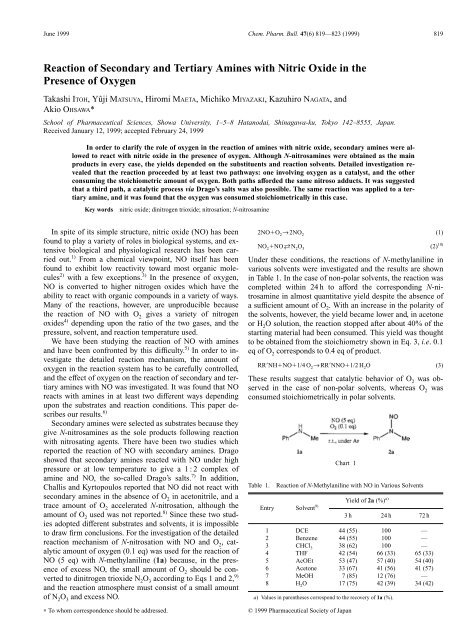
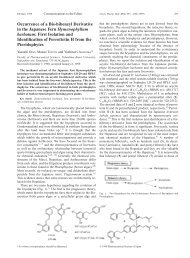

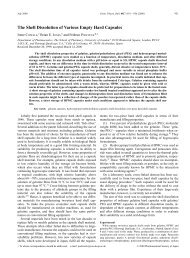
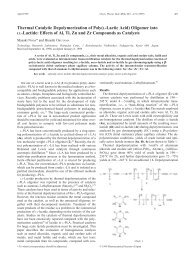
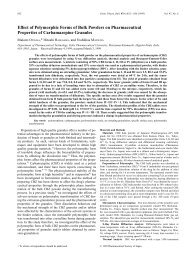
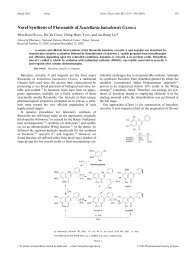
![Synthesis of 1-Azabicyclo[3.3.0]octane Derivatives and Their Effects ...](https://img.yumpu.com/5454096/1/190x259/synthesis-of-1-azabicyclo330octane-derivatives-and-their-effects-.jpg?quality=85)